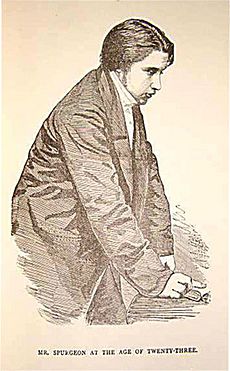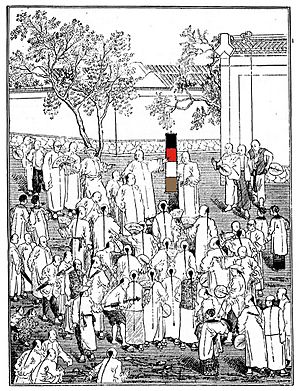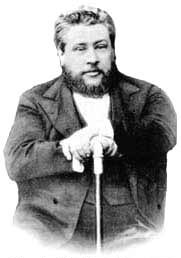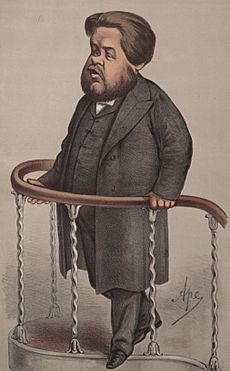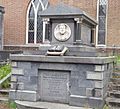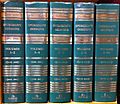Charles Spurgeon facts for kids
Quick facts for kids
Charles Haddon Spurgeon
|
|
|---|---|
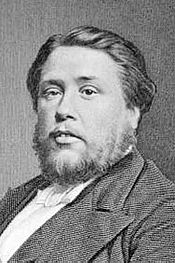 |
|
| Born | June 19, 1834 |
| Died | January 31, 1892 (aged 57) |
| Resting place | West Norwood Cemetery, London |
| Nationality | British |
| Occupation | Pastor, author |
| Spouse(s) | Susannah Spurgeon |
| Children | Charles & Thomas Spurgeon (twins, b. 1856) |
| Parent(s) | John and Eliza Spurgeon |
Charles Haddon Spurgeon (born June 19, 1834 – died January 31, 1892) was a famous English preacher. Many people called him the "Prince of Preachers" because he was so good at speaking. He spoke to millions of people during his life, sometimes even ten times a week! His talks, called sermons, were translated into many languages. Even today, more books and writings by Spurgeon exist than by almost any other Christian writer.
Spurgeon was the main pastor of the Metropolitan Tabernacle church in London for 38 years. This church became the largest Baptist church in Great Britain. Throughout his life, Spurgeon faced challenges with his health, including periods of sadness. In 1857, he started a charity called Spurgeon's that helps people all over the world.
About Charles Spurgeon
His Early Life
Family and Childhood
Charles Spurgeon was born on June 19, 1834, in Kelvedon, a town in Essex, England. He was the oldest child of Eliza and John Spurgeon. His mother, Eliza, was about 19 when he was born, and his father, John, was about 24. Charles was one of 17 children in his family, but sadly, nine of his brothers and sisters died when they were babies.
What He Enjoyed
When Charles was six years old, he read a famous book called The Pilgrim's Progress. He loved it so much that he read it more than 100 times in his life! Charles was also very good at mathematics. As a young boy, he would read from the Bible during family worship. He learned many hymns by heart, and he used them in his sermons later on.
His Spiritual Journey
As a teenager, Charles was very smart, but he also felt worried and had many questions. His father and grandfather taught him good values. At first, he thought he was a good person. But later, he felt a heavy weight on his heart. He read the whole Bible, but he felt like it was warning him, not promising him good things. These thoughts bothered him more and more as he grew older.
On January 6, 1850, when he was 15, a snowstorm made him stop at a small church in Colchester. Inside, a worker saw him and said, "Young man, you look very sad." Charles knew it was true and felt that only God could help him. The worker then told him, "Young man, look to Jesus Christ! Look! Look! Look! You have nothing to do but to look and live."
Right away, Charles felt a big change in his heart. He said, "God opened his heart to the message of Salvation." He felt so happy that he said, "I thought I could dance all the way home." On May 3, 1850, he was baptized in the River Lark. Later that year, his family moved to Cambridge.
Becoming a Preacher
Starting Out
Charles preached his very first sermon in the winter of 1850–51. Soon after, he became the pastor of the Waterbeach Baptist Chapel. People thought his preaching was excellent. In 1853, he wrote his first short book, called a Gospel tract.
Moving to London
In April 1854, when he was just 19, Charles became the pastor of the New Park Street Chapel in London. This was the biggest Baptist church in the city. Within a few months, Spurgeon became very famous. Even before he turned 20, he had preached over 600 times! His sermons were printed every week, and many people read them. While at this church, Spurgeon became friends with Hudson Taylor, who started a mission to China.
Spurgeon's way of preaching was easy to understand. When he taught from the Bible, many people were deeply touched. The church grew so large that they had to move to bigger places like Exeter Hall and the Surrey Music Hall. Eventually, they moved to the Metropolitan Tabernacle. By age 22, he was incredibly popular, preaching to more than 10,000 people at a time. He even spoke to almost 24,000 people at the Crystal Palace before microphones were invented!
On January 8, 1856, Spurgeon married Susannah Spurgeon. They had twin sons, Charles and Thomas, born on September 20, 1856. Sadly, by the age of 33, Susannah had to stay home often due to her health.
A Difficult Time
On October 19, 1856, something very sad happened while he was preaching. Some people in the crowd yelled "Fire!" This caused many people to panic and rush for the exits. Seven people died after being trampled. This event deeply affected Spurgeon, and he struggled with sadness for many years. He later said he would cry for no reason, but he kept on with his ministry.
Middle Years
On March 18, 1861, the church moved into their brand-new building, the Metropolitan Tabernacle, in London. This huge building could hold five to six thousand people, like a modern "megachurch." Spurgeon loved to read, sometimes as many as six books a week.
Spurgeon also enjoyed singing hymns and wrote several himself. He published a book of popular hymns for his church to use. His church did not have a pipe organ or other instruments; the hymns were always sung without music. Spurgeon did not ask people to come forward after his sermons, which is a common practice in some churches. Instead, he would invite anyone to meet him on Monday to talk about Jesus. There was always someone at his door the next day. He preached at the Metropolitan Tabernacle until he died 31 years later.
When the famous explorer David Livingstone died in 1873, a copy of one of Spurgeon's sermons was found among his things. Livingstone had written "Very good, D.L." on the first page. He carried this sermon with him on his travels in Africa. Spurgeon had preached this sermon on September 8, 1861, after two train accidents happened near his home in London. These accidents caused many deaths and injuries.
His Final Years
Spurgeon gave his last sermon at the Metropolitan Tabernacle on June 7, 1891. During his time as pastor, 14,692 people were baptized and joined the church.
Near the end of his life, Spurgeon had poor health with several illnesses. He died in Menton, France, on January 31, 1892. His wife and sons lived longer than him. His body is buried in a tomb in West Norwood Cemetery, in London.
Spurgeon's Ministries
Spurgeon's Charity
In 1867, Spurgeon started an orphanage in London called Stockwell Orphanage. It opened on September 9, 1869, first for boys, and then for girls starting in 1879. The children received food, clothes, and education at the orphanage. The money to run it mostly came from donations.
The orphanage stayed open until London was bombed during World War II. It later became Spurgeon's Child Care, and is now simply called Spurgeon's. Today, it mainly works in England but also has projects in other countries like Mexico, Africa, and Eastern Europe.
Spurgeon's College
Spurgeon's College is a school in London where people study to become pastors or learn about Christian faith. Spurgeon started it in 1857. It is part of the Baptist Union.
Spurgeon's Library
Charles Spurgeon had a very large personal library of books. In 1906, a college in Missouri, USA, bought most of his library, which had about 5,100 books. Later, in 2006, the entire library was sold to another seminary. Some of Spurgeon's original sermon notes are kept at a university in Alabama.
His Writings
Spurgeon wrote many books, commentaries, and collections of wise sayings. His writings have been translated into many languages around the world. Some of his well-known works include:
- All of Grace
- Chequebook of the Bank of Faith
- John Ploughman’s Talks
- Lectures to My Students
- Morning & Evening (a daily devotional book)
- The Soul Winner
- The Treasury of David (a commentary on the Book of Psalms)
- The Wordless Book
Images for kids
-
Spurgeon preaching at the Surrey Music Hall circa 1858.
See also
 In Spanish: Charles Spurgeon para niños
In Spanish: Charles Spurgeon para niños


